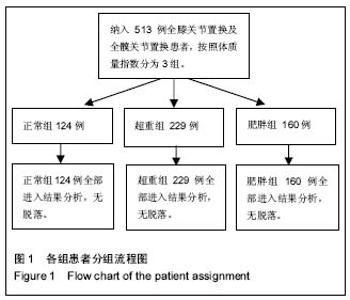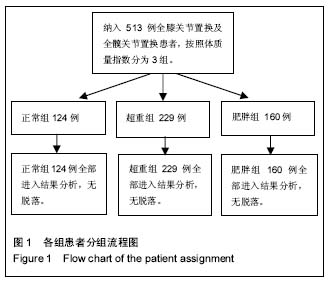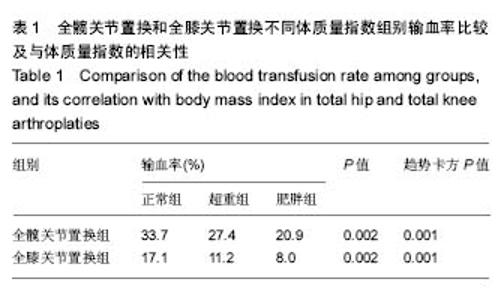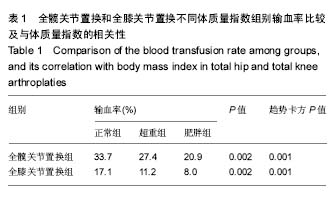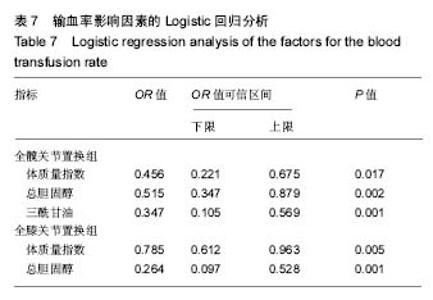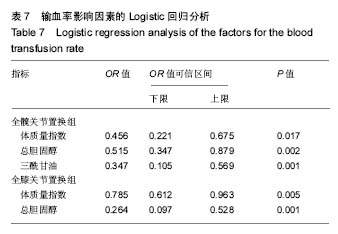Chinese Journal of Tissue Engineering Research ›› 2017, Vol. 21 ›› Issue (35): 5609-5615.doi: 10.3969/j.issn.2095-4344.2017.35.006
Previous Articles Next Articles
Correlation of body mass index and serum lipid levels in blood management of arthroplasty in elderly patients
Yan Jian-feng, Li Qiang, Yang Zong-hua
- Department of Orthopedics, Changshu No. 2 People’s Hospital (the Affiliated Hospital of Yangzhou University Medical College), Changshu 215500, Jiangsu Province, China
-
Online:2017-12-18Published:2018-01-02 -
About author:Yan Jian-feng, Associate chief physician, Department of Orthopedics, Changshu No. 2 People’s Hospital (the Affiliated Hospital of Yangzhou University Medical College), Changshu 215500, Jiangsu Province, China
CLC Number:
Cite this article
Yan Jian-feng, Li Qiang, Yang Zong-hua. Correlation of body mass index and serum lipid levels in blood management of arthroplasty in elderly patients [J]. Chinese Journal of Tissue Engineering Research, 2017, 21(35): 5609-5615.
share this article
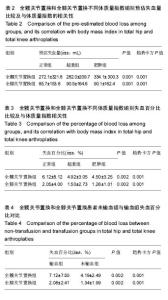
全髋关节置换患者中正常组、超重组和肥胖组预估失血量差异有显著性意义(P=0.001)。全膝关节置换患者中正常组、超重组和肥胖组预估失血量经卡方分析,各组间差异差异有显著性意义(P=0.001)。经趋势卡方检验,全膝关节置换和全髋关节置换患者其不同组别预估总失血量与体质量指数上升趋势相关性有统计学意义(P=0.001,0.001),提示随着体质量指数上升总失血量提高,见表2。 研究对象体质量指数越高,其失血百分比(失血量占总血容量百分比)越低,经趋势卡方检验,上述指标相关性有统计学意义(P=0.001,0.001),见表3。全髋关节置换和全膝关节置换患者中未输血组与输血组失血百分比对比见表4。"
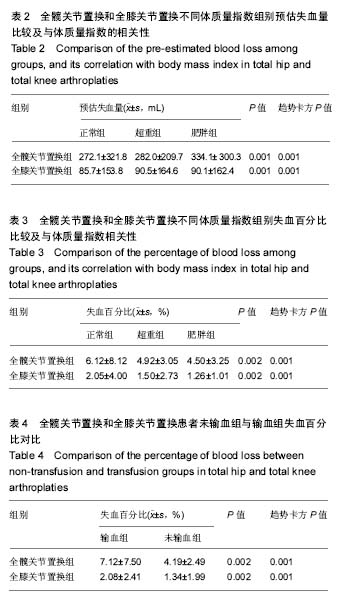
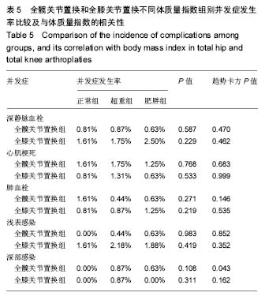
2.3 不同体质量指数组别术后并发症发生情况 全髋关节置换正常组、超重组和肥胖组的深静脉血栓发生率经卡方分析,各组间差异无显著性意义(P=0.587);全膝关节置换正常组、超重组和肥胖组经卡方分析,各组间差异无显著性意义(P=0.229)。全髋关节置换3组心肌梗死发生率经卡方分析,各组间差异无显著性意义(P=0.768);全膝关节置换3组心肌梗死发生率经卡方分析,各组间差异无显著性意义(P=0.534)。全髋关节置换3组手术部位深部感染发生率经卡方分析,各组间差异无显著性意义(P=0.108);全膝关节置换3组手术部位深部感染发生率经卡方分析,各组间差异无显著性意义(P=0.311)。趋势卡方检验分析提示,除手术部位深部感染发生率组别变化趋势与体质量指数增长具有相关性(P=0.043),其他并发症发生率组别变化趋势与体质量指数增长无关,见表5。 另外,根据基线资料和手术资料分析结果,体质量指数与住院时长、30 d再入院率、术前血红蛋白水平无显著相关性,体质量指数与年龄呈负相关,与血红蛋白1A水平、手术时长呈正相关。"
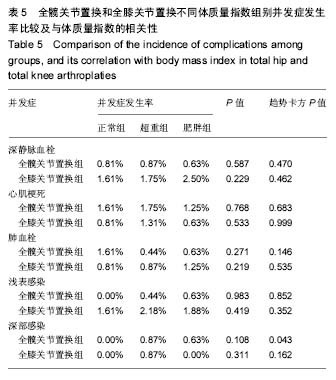
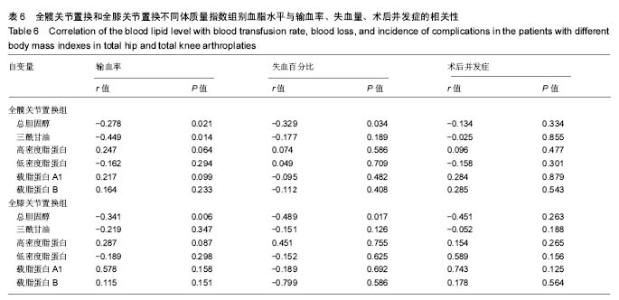
2.4 血脂水平相关指标与输血率、失血量及术后并发症发生率相关性 根据实验室检查结果,利用Spearman相关分析血脂水平与输血率、失血量及术后并发症发生率相关性。其中全髋关节置换组别中研究对象总胆固醇水平与输血率、失血百分比具有相关性,相关系数r分别为-0.278 (P=0.021)及-0.329(P=0.034)。三酰甘油水平与输血率具有相关性,相关系数r为-0.449(P=0.014)。其余指标与输血率、失血量及术后并发症发生率均无相关性。全膝关节置换组别中研究对象总胆固醇水平与输血率、失血百分比具有相关性,相关系数r分别为-0.341(P=0.006)及-0.489(P=0.017)。其余指标与输血率、失血量及术后并发症发生率均无相关性,详见表6。"
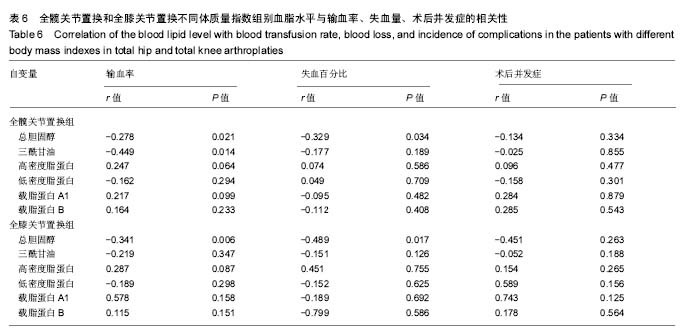
| [1] 李林涛,吴海山,吴宇黎,等. 人工关节置换术围手术期的血液管理策略[J]. 中国修复重建外科杂志,2015,29(6):772-776.[2] 田华,王金波. 输血对关节置换老年患者认知能力的影响[J]. 解放军预防医学杂志, 2016,34(1):71-72.[3] 张克云,余黎明,张绪华,等. 高龄老人髋关节置换的高危因素:128例特征[J]. 中国组织工程研究,2014,18(9):1331-1336.[4] 谢锦伟,徐彬,康鹏德,等. 全髋关节置换术后使用自体血回输引流装置有效性及安全性的Meta分析[J]. 中华外科杂志, 2016, 54(2):108-113.[5] Lin SY, Chen CH, Fu YC, et al. The efficacy of combined use of intraarticular and intravenous tranexamic acid on reducing blood loss and transfusion rate in total knee arthroplasty. J Arthroplasty. 2015;30(5):776-780.[6] ZF Y, HY, WP M, et al. The combined effect of administration of intravenous and topical tranexamic acid on blood loss and transfusion rate in total knee arthroplasty: Combined tranexamic acid for TKA. Bone Joint Res. 2016;5(8):353-361.[7] Chebli C. CORR Insights ® : What are risk factors for 30-day morbidity and transfusion in total shoulder arthroplasty? A review of 1922 cases. Clin Orthop Relat Res. 2015;473(6): 1-2.[8] Pongcharoen B, Ruetiwarangkoon C. Does tranexamic acid reduce blood loss and transfusion rates in unicompartmental knee arthroplasty? J Orthop Sci. 2016;21(2):211-215.[9] Saku SA, Madanat R, Mäkinen TJ.Reasons and risk factors for ninety day re-admission following primary total knee arthroplasty in a high-volume centre.Int Orthop. 2017. doi: 10.1007/s00264-017-3676-y.[10] 尹勇,马广文,黄斐,等. 氨甲环酸减少全髋关节置换失血量的Meta分析[J]. 中国组织工程研究,2014,18(17):2752-2757.[11] Mufarrih SH, Qureshi NQ, Ali A, et al. Total knee arthroplasty: risk factors for allogeneic blood transfusions in the South Asian population.BMC Musculoskelet Disord. 2017;18(1):359.[12] Yoo M J, Park H G, Ryu J W, et al. The efficacy and safety of autologous transfusion in unilateral total knee arthroplasty. Knee Surg Relat Res. 2015;27(3):168-172.[13] Guzel Y, Gurcan OT, Golge UH, et al. Topical tranexamic acid versus autotransfusion after total knee arthroplasty. J Orthop Surg (Hong Kong). 2016;24(2):179-182. [14] Baker JE, Pavenski K, Pirani RA, et al. Universal tranexamic acid therapy to minimize transfusion for major joint arthroplasty: a retrospective analysis of protocol implementation. Can J Anaesth. 2015 Nov;62(11):1179-1187.[15] Han SB, Kim HJ, Kim TK, et al. Computer navigation is effective in reducing blood loss but has no effect on transfusion requirement following primary total knee arthroplasty: a meta-analysis. Knee Surg Sports Traumatol Arthrosc. 2016:1-8.[16] Jaszczyk M, Kozerawski D, Ko?odziej ?, et al. Effect of single preoperative dose of tranexamic acid on blood loss and transfusion in hip arthroplasty. 2015;17(3):265-273.[17] 王武炼,林丽琼,沈富儿,等.自体血回输在复杂人工全髋关节置换术围手术期的应用[J]. 福建中医药大学学报, 2013,23(2): 15-16.[18] Markel DC, Allen MW, Zappa NM. Can an arthroplasty registry help decrease transfusions in primary total joint replacement? A Quality Initiative. Clin Orthop Relat Res. 2016;474(1):126-131. [19] Lee QJ, Mak WP, Yeung ST, et al. Blood management protocol for total knee arthroplasty to reduce blood wastage and unnecessary transfusion.J Orthop Surg. 2015;23(1): 66-70.[20] Young-Jun S, Jong-Keun S, Seung-Hun L, et al. Effect of tranexamic acid on blood loss and blood transfusion reduction after total knee arthroplasty. Knee Surg Relat Res. 2016;28(3): 188-193.[21] 岳辰,马俊,杨沛青,等. 氨甲环酸减少同期双侧全髋置换围术期失血有效性及安全性研究[J]. 中国矫形外科杂志, 2014,22(10): 865-869.[22] 冯硕,吴居泰,查国春,等.关节腔内注射氨甲环酸对单髁置换术围手术期失血量的影响[J].中华骨与关节外科杂志,2016,9(5): 402-406.[23] 周根荣,朱民新,吴建华. 自体血液回输对老年患者全髋关节置换术输血及凝血功能的影响分析[J]. 浙江临床医学, 2015, 17(6):923-924.[24] Kandil A, Griffin JW, Novicoff WM, et al. Blood transfusion after total shoulder arthroplasty: Which patients are at high risk? Int J Shoulder Surg. 2016;10(2):72-77.[25] Xie H, Pan JK, Hong KH, et al. Postoperative autotransfusion drain after total hip arthroplasty: a meta-analysis of randomized controlled trials. Sci Rep. 2016;6:27461. [26] Thacker JM, Li LP, Li W, et al. Renal blood oxygenation level-dependent magnetic resonance imaging: a sensitive and objective analysis. Invest Radiol. 2015;50(12):821-827. [27] Bagsby DT, Samujh CA, Vissing JL, et al. Tranexamic acid decreases incidence of blood transfusion in simultaneous bilateral total knee arthroplasty. J Arthroplasty. 2015;30(12): 2106-2109.[28] Anthony CA, Westermann RW, Gao Y, et al. What are risk factors for 30-day morbidity and transfusion in total shoulder arthroplasty? a review of 1922 cases. Clin Orthop Relat Res. 2015;473(6):2099-2105.[29] 刘丙根, 庞清江. 氨甲环酸用于全髋关节置换有效性与安全性的Meta分析[J]. 中国组织工程研究, 2014, 18(35):5699-5706.[30] 杨文彬. 农村高血压人群体质指数与血脂水平的相关性研究[D]. 安徽医科大学, 2016. |
| [1] | Yang Xue, Wang Baoqun, Jiang Xiaowen, Zou Shengcan, Ming Jinfa, Lin Shasha. Preparation and properties of biodegradable plant polysaccharide hemostatic microspheres [J]. Chinese Journal of Tissue Engineering Research, 2022, 10(16): 2607-2611. |
| [2] | Liu Jiali, Suo Hairui, Yang Han, Wang Ling, Xu Mingen. Influence of lay-down angles on mechanical properties of three-dimensional printed polycaprolactone scaffolds [J]. Chinese Journal of Tissue Engineering Research, 2022, 10(16): 2612-2617. |
| [3] | Li Shengkai, Li Tao, Wei Chao, Shi Ming. Comparison of biomechanical properties of calcium phosphate/polymethyl methacrylate composite bone cement and polymethyl methacrylate bone cement [J]. Chinese Journal of Tissue Engineering Research, 2022, 10(16): 2581-2586. |
| [4] | Liu Xiaojun, Xu Yuyin, Liu Kangbo, Zhou Jing, Han Ying, Xiong Yue, Tian Yuan. Preparation and properties of carboxymethylated cotton linters hemostatic gauze [J]. Chinese Journal of Tissue Engineering Research, 2022, 10(16): 2593-2599. |
| [5] | Huang Bo, Chen Mingxue, Peng Liqing, Luo Xujiang, Li Huo, Wang Hao, Tian Qinyu, Lu Xiaobo, Liu Shuyun, Guo Quanyi . Fabrication and biocompatibility of injectable gelatin-methacryloyl/cartilage-derived matrix particles composite hydrogel scaffold [J]. Chinese Journal of Tissue Engineering Research, 2022, 10(16): 2600-2606. |
| [6] | Luo Di, Liang Xuezhen, Liu Jinbao, Li Jiacheng, Yan Bozhao, Xu Bo, Li Gang. Difference in osteogenesis- and angiogenesis-related protein expression in femoral head samples from patients with femoral head necrosis of different etiologies [J]. Chinese Journal of Tissue Engineering Research, 2022, 26(11): 1641-1647. |
| [7] | Zhu Chunhui, Zhang Yi, Song Huanghe, Liang Wenwei. Protective effect of astaxanthin on tert-butyl hydrogen peroxide-induced chondrocyte damage [J]. Chinese Journal of Tissue Engineering Research, 2022, 26(11): 1648-1655. |
| [8] | Zhao Tianyu, Jin Song, Zhang Di, Liu Xiaoxiao, Ma Jiang, Wang Ju. Baduanjin training for patellar tendinopathy in a randomized controlled trial: improving pain, muscle flexibility and lower limb balance stability [J]. Chinese Journal of Tissue Engineering Research, 2022, 26(11): 1662-1668. |
| [9] | Zhang Lei, Xiu Chunmei, Ni Li, Chen Jianquan. Identification and expression analysis of mouse nucleus pulposus specific markers [J]. Chinese Journal of Tissue Engineering Research, 2022, 26(11): 1669-1674. |
| [10] | Yu Dong, Liu Kan, Shi Zongting, Yang Xiaoxia, Liu Hengping, Zhang Qingfeng. Pathological changes of the cervical intervertebral discs and rules of migration and apoptosis in endplate chondrocytes in a rabbit model of dynamic disequilibrium [J]. Chinese Journal of Tissue Engineering Research, 2022, 26(11): 1675-1679. |
| [11] | Tian Zhuang, Wang Diaodiao, Zhang Chu, Li Hanchen, Zhou Jian, Yao Qi. The mechanism by which bone morphogenetic protein 2 indirectly regulates sclerostin expression in osteocytes [J]. Chinese Journal of Tissue Engineering Research, 2022, 26(11): 1686-1691. |
| [12] | Li Jingyu, Su Yingying, Bai Ding. Morphological characteristics of subchondral bone in a mouse model of early osteoarthritis [J]. Chinese Journal of Tissue Engineering Research, 2022, 26(11): 1692-1698. |
| [13] | Bao Hongyu Lü Dongmei, He Yun, Xia Delin, Chen Junliang. Incidence of osteonecrosis in rats with jaw versus femoral defects following zoledronic acid injection [J]. Chinese Journal of Tissue Engineering Research, 2022, 26(11): 1699-1704. |
| [14] | Tan Qian, Li Bocun, Li Jing, Li Jia, Xiang Hongchun, Cai Guowei. Acupuncture combined with moxibustion regulates the expression of circadian clock protein in the synovium of rats with osteoarthritis [J]. Chinese Journal of Tissue Engineering Research, 2022, 26(11): 1714-1719. |
| [15] | Fei Jing, Tao Meihui, Li Leiji. Electroacupuncture promotes facial nerve regeneration in a rat model of facial nerve crush [J]. Chinese Journal of Tissue Engineering Research, 2022, 26(11): 1728-1733. |
| Viewed | ||||||
|
Full text |
|
|||||
|
Abstract |
|
|||||
